University of Strasbourg. The half-a-millennium-old German-founded alma mater of French science and learning. Where the great plant science cheater Olivier Voinnet did his magic at the CNRS’ Institut de biologie moléculaire des plantes (IBMP) before he got stranded as professor at ETH Zürich in Switzerland. I wrote a lot about Voinnet, and I wrote a lot about his cheating colleagues at IBMP, including its director Laurence Drouard. But it seems, everything at the University of Strasbourg is rotten, not just plant science.
Olivier Voinnet, the new Dreyfus?
Much of French media and academia, and certainly also the international plant science community now debates a hot conspiracy theory: what if Olivier Voinnet is actually innocent, a visionary genius who fell prey to a conspiracy of fraudulent colleagues and scheming bureaucrats? I discuss here the widespread dishonesty and data manipulation among Voinnet’s co-authors and…
The travelling circus of research integrity in Strasbourg
On March 8, an international scientific review board will be evaluating the research at the French CNRS Institut de Biologie Moléculaire des Plantes (IBMP) in Strasbourg. This is the place where the former star (and now misconduct-tainted pariah) of plant sciences Olivier Voinnet shot to fame, where his main lab operated since 2002 until he was…
Strasbourg is so parochial that professorships are inherited there along the academic bloodline based on garbage science. IBMP provides a good example. The research director Marie-Edith Chabouté inherited her position from her retired mentor Anne-Catherine Schmitt, for Chaboute’s qualifications see this example of their joint paper:
Natacha Janski , Kinda Masoud , Morgane Batzenschlager , Etienne Herzog, Jean-Luc Evrard, Guy Houlné, Mickael Bourge, Marie-Edith Chabouté, Anne-Catherine Schmitt The GCP3-interacting proteins GIP1 and GIP2 are required for γ-tubulin complex protein localization, spindle integrity, and chromosomal stability The Plant Cell (2012) doi: 10.1105/tpc.111.094904




The co-author Jean-Luc Evrard used to be vice-director of IBMP and he also used to send me nasty messages to discourage me from reporting on the fraud at IBMP. As it happens, Chaboute’s PhD student Alexandre Berr is currently IBMP’s uncommunciative PR person and a designated heir to his mentor’s lab once she retires. Chaboute managed to avoid any journal action on the above Plant Cell paper, fixed another fraudulent study at Frontiers (Batzenschlager et al 2013) with a correction, but another paper got retracted. It was just way too fake:
Laetitia Paganelli , Marie‐Cécile Caillaud , Michaël Quentin , Isabelle Damiani , Benjamin Govetto , Philippe Lecomte , Pavel A. Karpov , Pierre Abad , Marie‐Edith Chabouté , Bruno Favery Three BUB 1 and BUBR 1/ MAD 3‐related spindle assembly checkpoint proteins are required for accurate mitosis in Arabidopsis The New phytologist (2015)doi: 10.1111/nph.13073
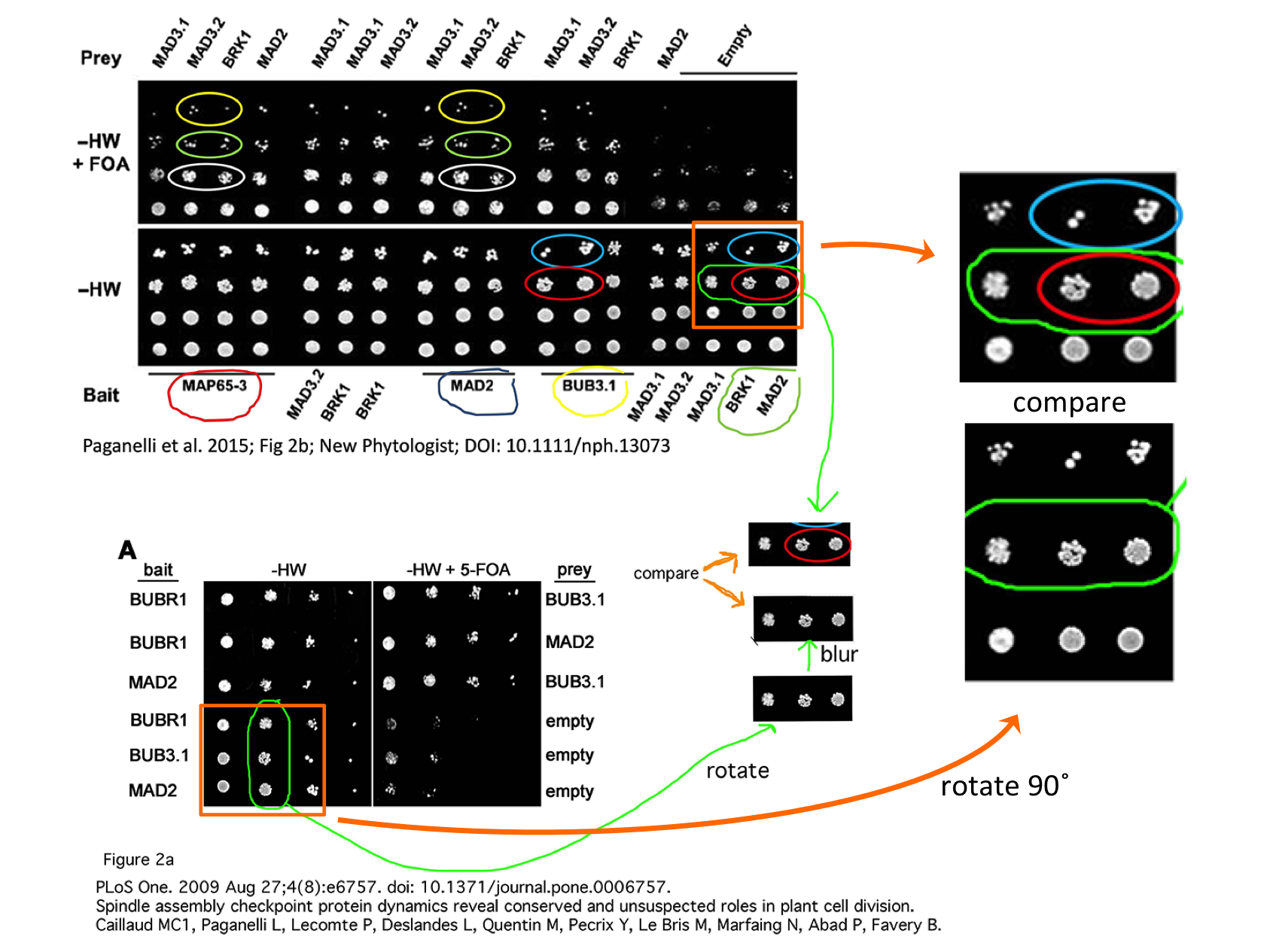
Although, to be fair, the fraud was likely committed in Bruno Flavery‘s lab at the University of Côté d’Azur, as the retraction notice mentioned:
“…it has been brought to our attention that errors occurred in the construction of Figs 1 and 2(a); some components were inappropriately edited and duplicated, including the duplication and editing of images that first appeared in Caillaud et al. (2009), which were used by the authors as a basic template.”
So before you run off to the sunny Mediterranean coast and start discussing the fraud in Marseille even, we return to Strasbourg.
Of course also spouses and other relatives get provided for. Meet Monsieur and Madame Egly of the University of Strasbourg, both cancer researchers at the CNRS-INSERM Institut de Génétique et de Biologie Moléculaire et Cellulaire (IGBMC) who have lovely PubPeer records: 15 papers for the Cécile Rochette-Egly, and only 6 (but quality) entries for Jean-Marc Egly. Here an example for the Madame:
Martin Bommer , Arndt Benecke , Hinrich Gronemeyer, Cécile Rochette-Egly TIF2 mediates the synergy between RARalpha 1 activation functions AF-1 and AF-2 The Journal of biological chemistry (2002) doi: 10.1074/jbc.m206001200

The above JBC paper was with Germans, this one with Italians, but just as rigged:
Maurizio Gianní , Anne Tarrade , Elisa Agnese Nigro , Enrico Garattini , Cécile Rochette-Egly The AF-1 and AF-2 domains of RAR gamma 2 and RXR alpha cooperate for triggering the transactivation and the degradation of RAR gamma 2/RXR alpha heterodimers The Journal of biological chemistry (2003) doi: 10.1074/jbc.m304952200


This one isn’t trustworthy either:
Maurizio Giannì , Annie Bauer , Enrico Garattini, Pierre Chambon , Cécile Rochette-Egly Phosphorylation by p38MAPK and recruitment of SUG-1 are required for RA-induced RAR gamma degradation and transactivation The EMBO Journal (2002) doi: 10.1093/emboj/cdf374

Madame Egly mumbled something nonsensical on PubPeer about “did not reimmunoblotted“, and added:
“Anyhow it does not change the message of the paper and we observed so many times the degradation of RARg in response to RA and its reversal with MG132.“
The husband, who is known in Strasbourg for a somewhat violent personality, showed himself however very polite by commenting on PubPeer about this paper:
Emmanuel Compe , Pascal Drané , Camille Laurent , Karin Diderich , Cathy Braun , Jan H. J. Hoeijmakers, Jean-Marc Egly Dysregulation of the peroxisome proliferator-activated receptor target genes by XPD mutations Molecular and Cellular Biology (2005) doi: 10.1128/mcb.25.14.6065-6076.2005



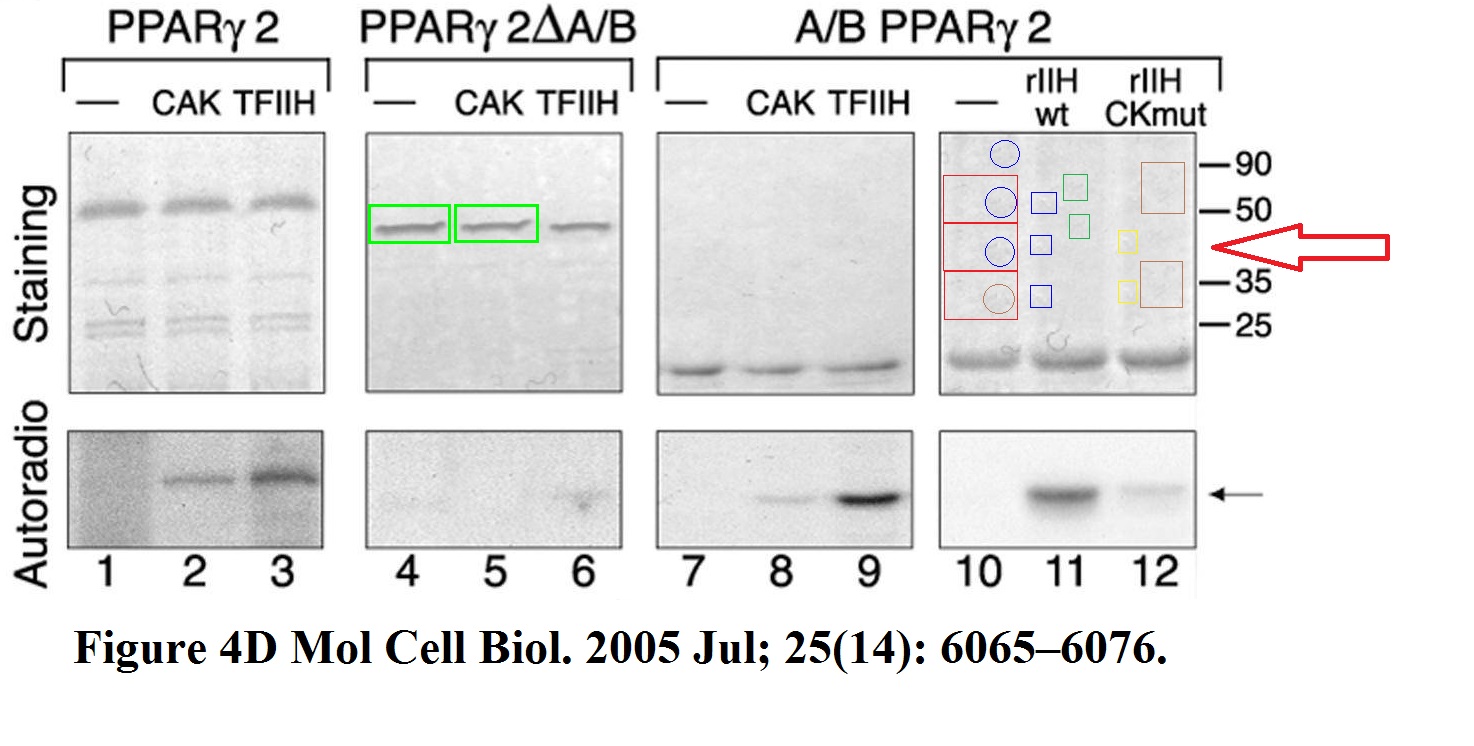
Monsieur Egly posted some freshly cooked data and informed everyone:
“We have full confidence in the findings and conclusions of the paper. However, in the interest of maintaining accuracy in the published scientific literature, we wish to contact the editorial in Molecular and Cellular Biology.“
He did same on other PubPeer threads. Of course, no corrections were issued, for neither of Eglys (except once in 2017, for Cassinat et al 2011). In Strasbourg, nobody cares anyway.


As it happens, Monsieur Egly collaborated with the Greek fraudster Maria Fousteri, and together with her very influential former mentor Jesper Svejstrup he made sure their common paper (Anindya et al Molecular Cell 2010) was not retracted despite requests from the investigating Dutch university.
Fousteri affair: Dutch integrity thwarted by academic indecency
Two and a half years after Maria Fousteri was found guilty of scientific misconduct by her former employer, the Leiden University Medical Center (LUMC), exactly nothing at all happened. ERC and Molecular Cell ignored LUMC letters from June 2016, while Fouster’s British co-authors interfered to save own papers. Of 4 scheduled retractions, none took place.
Now, meet Jean-Philippe Loeffler, neuroscience professor at the University of Strasbourg and research director at the U692 INSERM institute. Like Egly, Loeffler graduated in Strasbourg and only once temporarily left the university for a postdoc abroad. Loeffler does research on amyotrophic lateral sclerosis (ALS) and gives hope to many suffering patients. Apparently, this incurable degenerative disease can be easily treated, just like cancer: with Photoshop!
For example, this PNAS paper was flagged on PubPeer in autumn 2018. It was editorially handled by the above-mentioned Strasbourg professor Pierre Chambon, because back then PNAS didn’t believe in conflicts of interests.
Luc Dupuis, Hugues Oudart , Frédérique Rene , Jose-Luis Gonzalez De Aguilar , Jean-Philippe Loeffler Evidence for defective energy homeostasis in amyotrophic lateral sclerosis: benefit of a high-energy diet in a transgenic mouse model Proceedings of the National Academy of Sciences (2004) doi: 10.1073/pnas.0402026101

Luc Dupuis, by now a group leader at the INSERM U1118 institute at the University of Strasbourg, commented in November 2018:
“As the first author of this manuscript, I thank you for this comment, and would like to clarify that the statement that these two images are identical is simply wrong.“
To prove his point Depuis posted enlargements of published figures (extremely low-resolution, and even that unconvincingly), because he wasn’t inclined to share the original data:
“Lab-notebooks from 2002 were traced back, and luckily conserved. Original data were retrieved and are available upon (non anonymous) request to any interested scientist.“
OK then. I asked Depuis for the raw data. He just didn’t reply.
Because of course the figures in this paper are manipulated. There was more:






Dupuis went quiet. He also didn’t comment on this paper:
Luc Dupuis , Franck Di Scala , Frédérique Rene, Marc De Tapia , Hugues Oudart , Pierre-François Pradat , Vincent Meininger , Jean-Philippe Loeffler Up‐regulation of mitochondrial uncoupling protein 3 reveals an early muscular metabolic defect in amyotrophic lateral sclerosis The FASEB Journal (2003) doi: 10.1096/fj.02-1182fje

Neither Loeffler nor Dupuis replied to emails. Silence on PubPeer also:
Franck Di Scala , Luc Dupuis , Christian Gaiddon , Marc De Tapia , Natasa Jokic , Jose-Luis Gonzalez De Aguilar , Jean-Sébastien Raul , Bertrand Ludes , Jean-Philippe Loeffler Tissue specificity and regulation of the N-terminal diversity of reticulon 3 The Biochemical journal (2005) doi: 10.1042/bj20040458


I did exchange some emails with Loeffler’s PhD student Violaine Sée (now professor at the University of Lyon), who promised to investigate. The situation is serious:
Violaine Sée , Jean-Philippe Loeffler Oxidative stress induces neuronal death by recruiting a protease and phosphatase-gated mechanism The Journal of biological chemistry (2001) doi: 10.1074/jbc.m104988200




How JBC sold its Soul to the Devil
All good things come to an end.
Another paper, in the same once very ethically-minded journal JBC, again from Loeffler lab:
Corinne Mbebi , Violaine Sée , Luc Mercken , Laurent Pradier , Ulrike Müller , Jean-Philippe Loeffler Amyloid precursor protein family-induced neuronal death is mediated by impairment of the neuroprotective calcium/calmodulin protein kinase IV-dependent signaling pathway The Journal of biological chemistry (2002) doi: 10.1074/jbc.m107948200

Loeffler also collaborated with other interesting Strasbourg researchers: the neuroscience professor Jean-Christophe Cassel, and his former PhD student, current lab co-director (and likely his partner), Anne-Laurence Boutillier. This couple also didn’t reply to my email when I asked for a comment about their joint papers on PubPeer. Here one with Loeffler, the digital gel lane splicing makes the whole figure unreliable:
Olivier Bousiges , Romain Neidl , Monique Majchrzak , Marc-Antoine Muller , Alexandra Barbelivien , Anne Pereira De Vasconcelos , Anne Schneider , Jean-Philippe Loeffler , Jean-Christophe Cassel , Anne-Laurence Boutillier Detection of histone acetylation levels in the dorsal hippocampus reveals early tagging on specific residues of H2B and H4 histones in response to learning PLoS ONE (2013) doi: 10.1371/journal.pone.0057816


Here we have See again as co-author, and it seems AL Boutillier brought her sister Stephanie with her.
Irina Panteleeva , Stéphanie Boutillier , Violaine See, Dave G Spiller, Caroline Rouaux, Geneviève Almouzni, Delphine Bailly, Christèle Maison, Helen C Lai , Jean-Philippe Loeffler , Anne-Laurence Boutillier HP1alpha guides neuronal fate by timing E2F-targeted genes silencing during terminal differentiation The EMBO Journal (2007) doi: 10.1038/sj.emboj.7601789




Another one, similar set of authors:
Irina Panteleeva , Caroline Rouaux , Yves Larmet , Stéphanie Boutillier , Jean-Philippe Loeffler , Anne-Laurence Boutillier HDAC-3 Participates in the Repression ofe2f-Dependent Gene Transcription in Primary Differentiated Neurons Annals of the New York Academy of Sciences (2004) doi: 10.1196/annals.1329.076

Or this:
Emmanuelle Trinh , Anne-Laurence Boutillier , Jean-Philippe Loeffler Regulation of the retinoblastoma-dependent Mdm2 and E2F-1 signaling pathways during neuronal apoptosis Molecular and cellular neurosciences (2001) doi: 10.1006/mcne.2000.0928

Much of the evidence you saw was originally posted on PubPeer by the pseudonymous sleuth Clare Francis. It seems they stumbled over Loeffler in 2015 when looking at the papers of a certain cheating US scientist, Carol Prives, professor at the Columbia University. Prives in turn collaborated with the Spanish zombie scientist Susana Gonzalez, another one of Clare Francis’ “customers”:
Carol Prives, innocent victim of Susana Gonzalez’ data manipulations?
Did NAS Member Carol Prives know anything about these suspected manipulations in her lab’s papers? And how will journals act on the evidence?
As it happens, Prives is the ex-wife of the US scientist Joav Prives, who in turn then betrothed Dafna Bar-Sagi, who in turn recently almost got a new job for the sacked sexual predator and mTOR cheater David Sabatini. Science is a village, and the crooks and their enablers form their own little sub-villages there.
The Sex Privileges of mTORman David Sabatini
“The Plaintiff is Professor Sabatini […] the self-described powerful senior scientist, who had demanded sex of her when she was a graduate student ending her studies and about to start a fellowship at the Whitehead, in a program Sabatini would direct. […] And it is the man who had made it clear – throughout her…
Anyway, here is Prives’ paper with Loeffler and their fudged figure. The first author is Prives’ former postdoc and now professor in Strasbourg: Christian Gaiddon. He has a PubPeer record while promising to cure cancer (“From the molecule to the patient“).
Christian Gaiddon, Maria Lokshin , Isabelle Gross , Danielle Levasseur , Yoichi Taya , Jean-Philippe Loeffler , Carol Prives Cyclin-dependent kinases phosphorylate p73 at threonine 86 in a cell cycle-dependent manner and negatively regulate p73 The Journal of biological chemistry (2003) doi: 10.1074/jbc.m300251200

From Prives, Clare Francis diversified not only to Loeffler, but to Isabelle Gross, another INSERM researcher in Strasbourg who graduated under the Strasbourg professor Jean-Noël Freund. With science like this, also Gaiddon is involved:
Isabelle Gross, Benoit Lhermitte Claire Domon-Dell, Isabelle Duluc , Elisabeth Martin , Christian Gaiddon, Michele Kedinger , Jean-Noël Freund Phosphorylation of the homeotic tumor suppressor Cdx2 mediates its ubiquitin-dependent proteasome degradation Oncogene (2005) doi: 10.1038/sj.onc.1208945





There is more Gross stuff on PubPeer. Here for example, a paper by Gaiddon, Gross and Loeffler:
Samir Benosman , Xiangjun Meng , Yannick Von Grabowiecki , Lavinia Palamiuc , Lucian Hritcu , Isabelle Gross , Georg Mellitzer , Yoichi Taya , Jean-Philippe Loeffler , Christian Gaiddon Complex regulation of p73 isoforms after alteration of amyloid precursor polypeptide (APP) function and DNA damage in neurons The Journal of biological chemistry (2011) doi: 10.1074/jbc.m111.261271

Here another one:
S Benosman , I Gross , N Clarke , A G Jochemsen , K Okamoto , J-P Loeffler , C Gaiddon Multiple neurotoxic stresses converge on MDMX proteolysis to cause neuronal apoptosis Cell Death & Differentiation (2007) doi: 10.1038/sj.cdd.4402216


None of these Loeffler papers is being retracted or even corrected. This is because the networks are working and because the University of Strasbourg protects fraud. Money doesn’t stink. They didn’t even care that Loeffler went to a predatory OMICS conference some years ago.

All that’s asked of the cheaters is to be more careful with their newer papers, i.e. not to get caught on duplicated pictures anymore, and even with such simple task these people occasionally fail. Here, by Mme Egly:
Maurizio Gianni , Mineko Terao , Mami Kurosaki , Gabriela Paroni , Laura Brunelli , Roberta Pastorelli , Adriana Zanetti , Monica Lupi , Andrea Acquavita , Marco Bolis , Maddalena Fratelli , Cecile Rochette-Egly , Enrico Garattini S100A3 a partner protein regulating the stability/activity of RARα and PML-RARα in cellular models of breast/lung cancer and acute myeloid leukemia Oncogene (2019) doi: 10.1038/s41388-018-0599-z

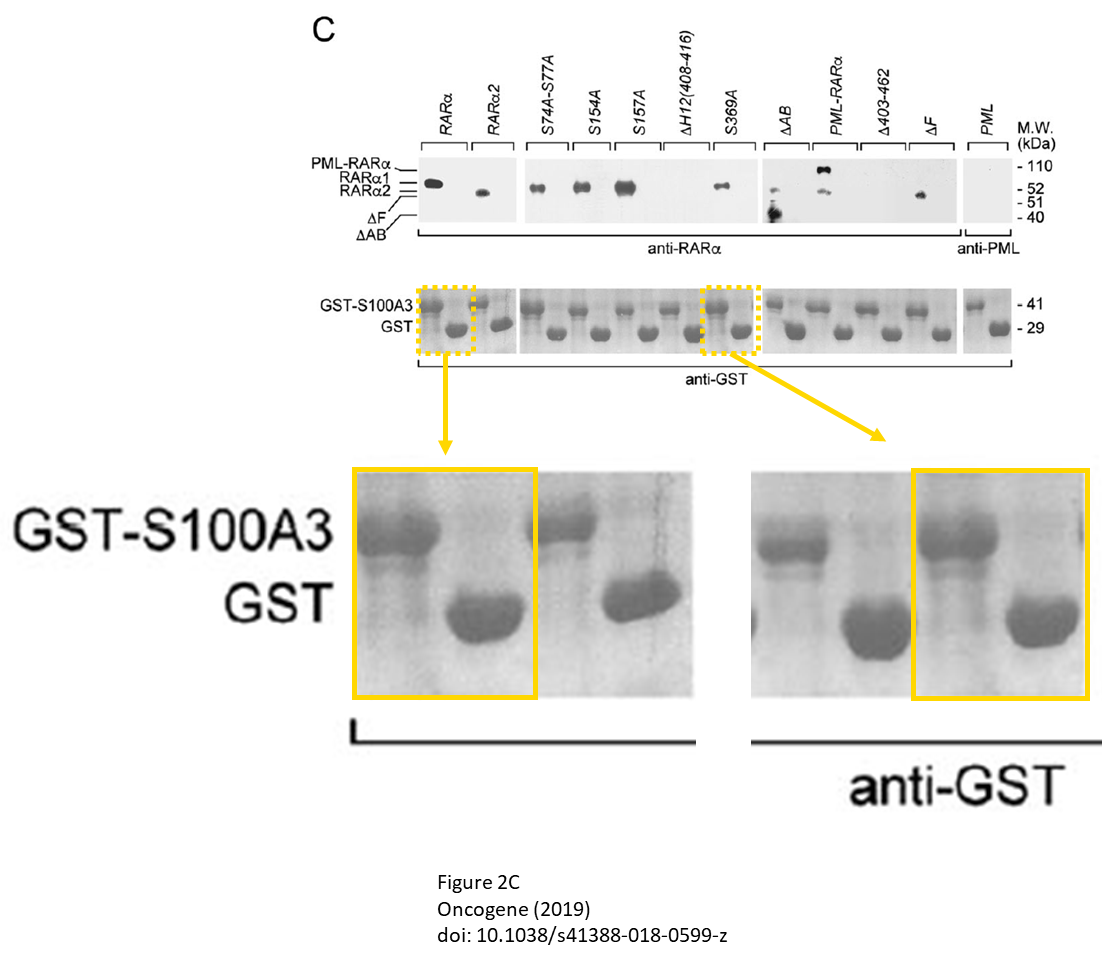
To round up the Strasbourg experience, here a story about Voinnet’s former boss, the IBMP director Laurence Maréchal-Drouard. You may have read it before in Shorts.
She has 18 of problematic papers on PubPeer, even occasional PhD dissertations under her supervision contain manipulated data. Especially the thesis of Thalia Salinas, who not only made it to the position of tenured IBMP researcher, but also as wife of the current adjunct director of IBMP, Philippe Giegé, who will soon succeed Drouard as the new IBMP director. Which is just as good, because Drouard is definitely not happy about her duty of teaching all IBMP PhD students research integrity in special courses (yep, she has to do that).
The stinking fish of Strasbourg
A 2014 publication from the lab of Laurence Maréchal-Drouard, director of CNRS IBMP institute in Strasbourg, seems to contain evidence of inappropriate data manipulation. Other versions of this problematic figure appear in 2 PhD dissertations supervised by Drouard
Call to research integrity, or at least a minor revolution at CNRS
When I first started digging into the affair of data manipulations around the former star of plant sciences Olivier Voinnet in early 2015, I was sure to be dealing with a singular case of fraud in French science, which went totally unnoticed for decades. When 2 years later I wrote “a fish stinks from the head down” in my…
When in 2018 CNRS set up a central research integrity office in the wake of the affairs of Voinnet, former CNRS chief biologist Catherine Jessus and former CNRS president Anne Peyroche, I used the opportunity to report Drouard for suspect research misconduct. The head of the new CNRS research integrity office, the physicist Rémy Mosseri, accepted my dossier and opened an investigation.
That was my report on the Drouard case:
Here an example:
Thalia Salinas, Cécile Schaeffer , Laurence Maréchal-Drouard, Anne-Marie Duchêne Sequence dependence of tRNA(Gly) import into tobacco mitochondria Biochimie (2005) doi: 10.1016/j.biochi.2005.04.004
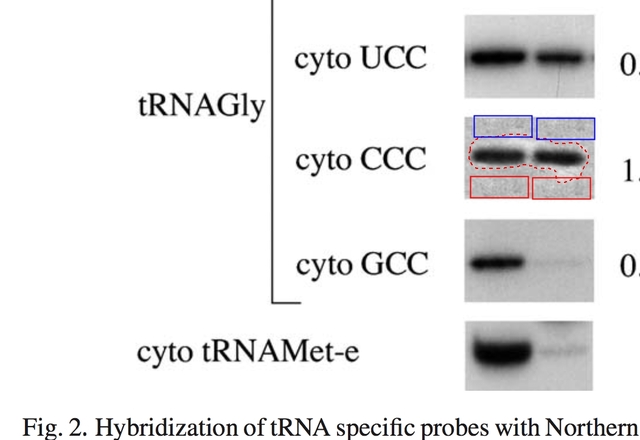
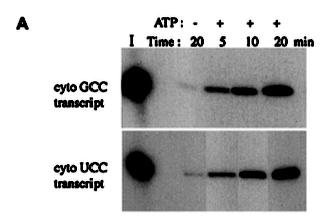
Mosseri wrote his own report, and in January 2020 he submitted it to the CNRS President Antoine Petit (the one who planned to deploy secret service technology to find out the identities of the “assholes” commenting on PubPeer).
Jessus investigator identity leaked, CNRS President to expose whistleblowers
An update to the ongoing cartoon Stalinism propaganda and purge activities at the EU largest research institution, the French CNRS, in the wake of the affair around manipulated data of CNRS chief biologist Catherine Jessus, according to their press release an innocent “victim” of my “slanderous” and “unscientific” blogging. First of all, a reliable source…
In October 2020, Mosseri told me:
“As you may now, I am not in charge of decisions (and their publicity) which can be taken once my report is sent to the CNRS president. So your question can only be addressed to him.”
Gosh, what punishment did Petit design for Drouard? Well, for starters, she got a new research grant in 2021.
And on 29 March 2022, on orders from CNRS President Petit personally, Drouard received a promotion from DR1 to DRCE (directeur de recherche de classe exceptionnelle), in the First Echelon no less. She is now officially France’s exceptional scientist, paid the highest salary. And all not despite but because her research papers are fake.
Now you probably think, well, what a rotten place Strasbourg is. I now must admit to have misinformed you. It’s not just Strasbourg which is problematic. It’s all of French academia. With the big cases like Didier Raoult in Marseille and Guido Kromer in Paris, the former French Minister for Research, Frédérique Vidal, and all the smaller cheaters all over the country, most of whom remain somehow protected one way or another. In the end, one cheating hand washes the other, as the Catherine Jessus affair proved.
Remember Charles-Henri Lecellier?
Charles-Henri Lecellier is about to get promoted to CNRS research director 2nd class. Time to dig up old stories and let the ghosts rise to wash their dirty laundry.
Vive La France.
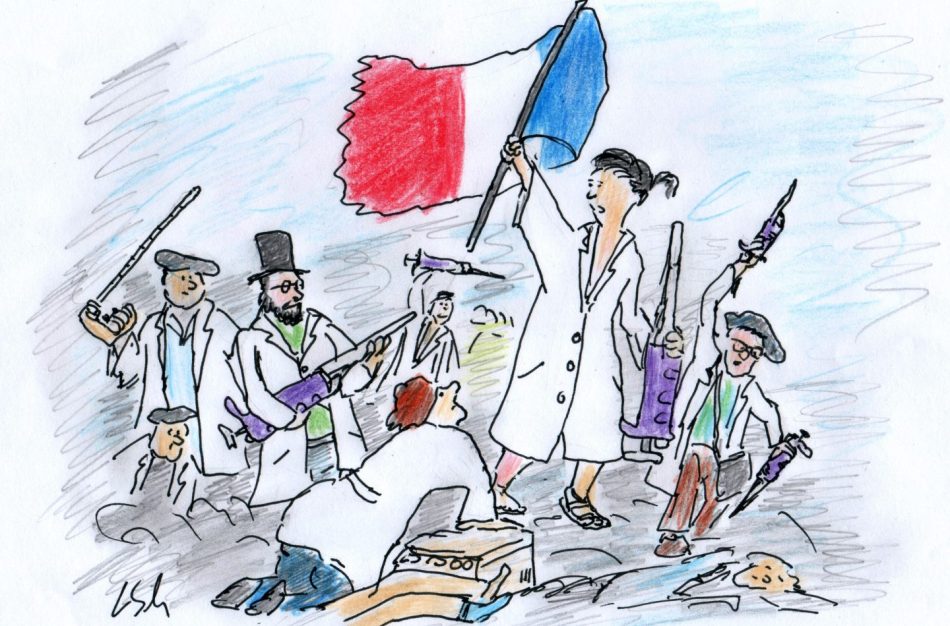
Note: some of the material was previously published on For Better Science.
I thank all my donors for supporting my journalism. You can be one of them!
Make a one-time donation:
I thank all my donors for supporting my journalism. You can be one of them!
Make a monthly donation:
Choose an amount
Or enter a custom amount
Your contribution is appreciated.
Your contribution is appreciated.
DonateDonate monthly


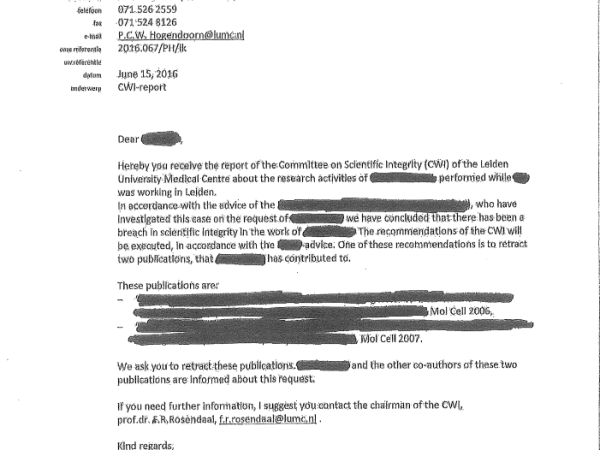


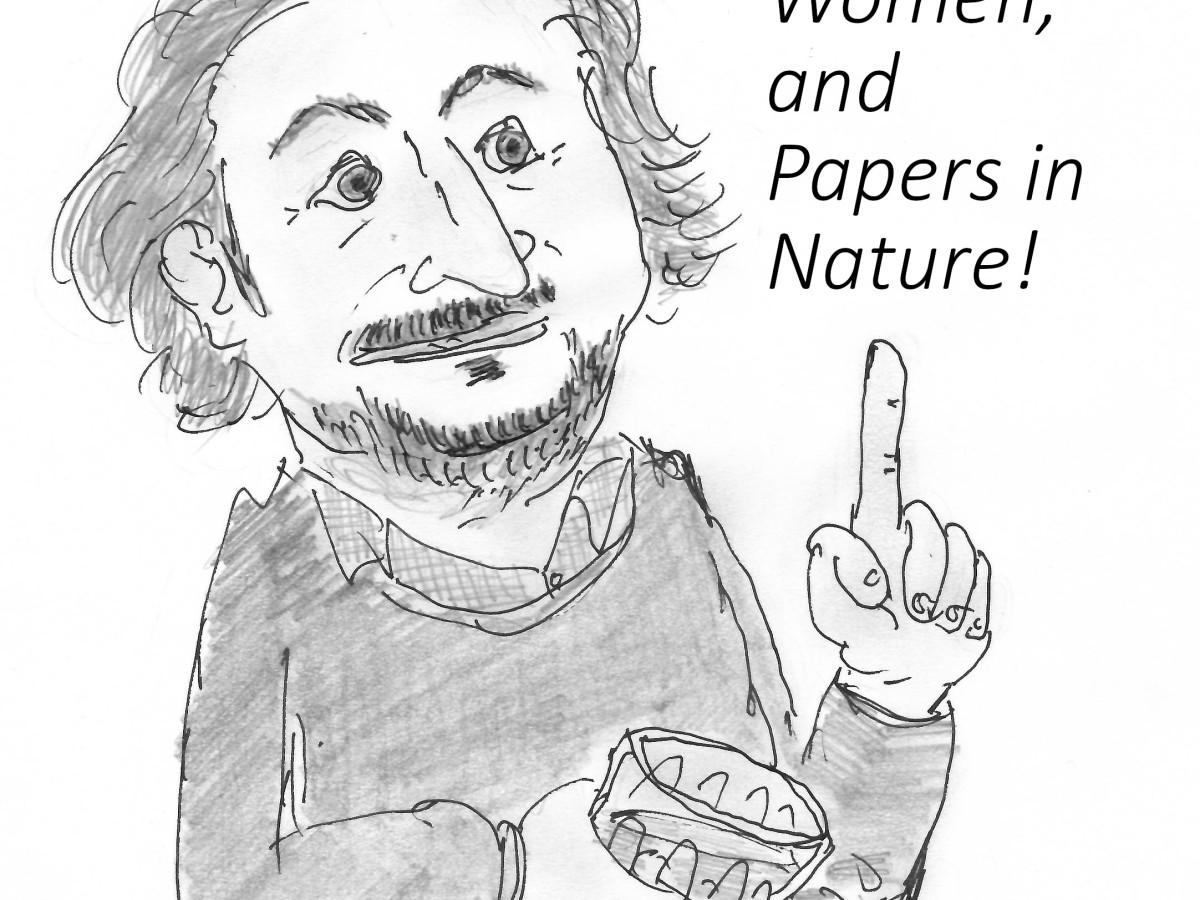

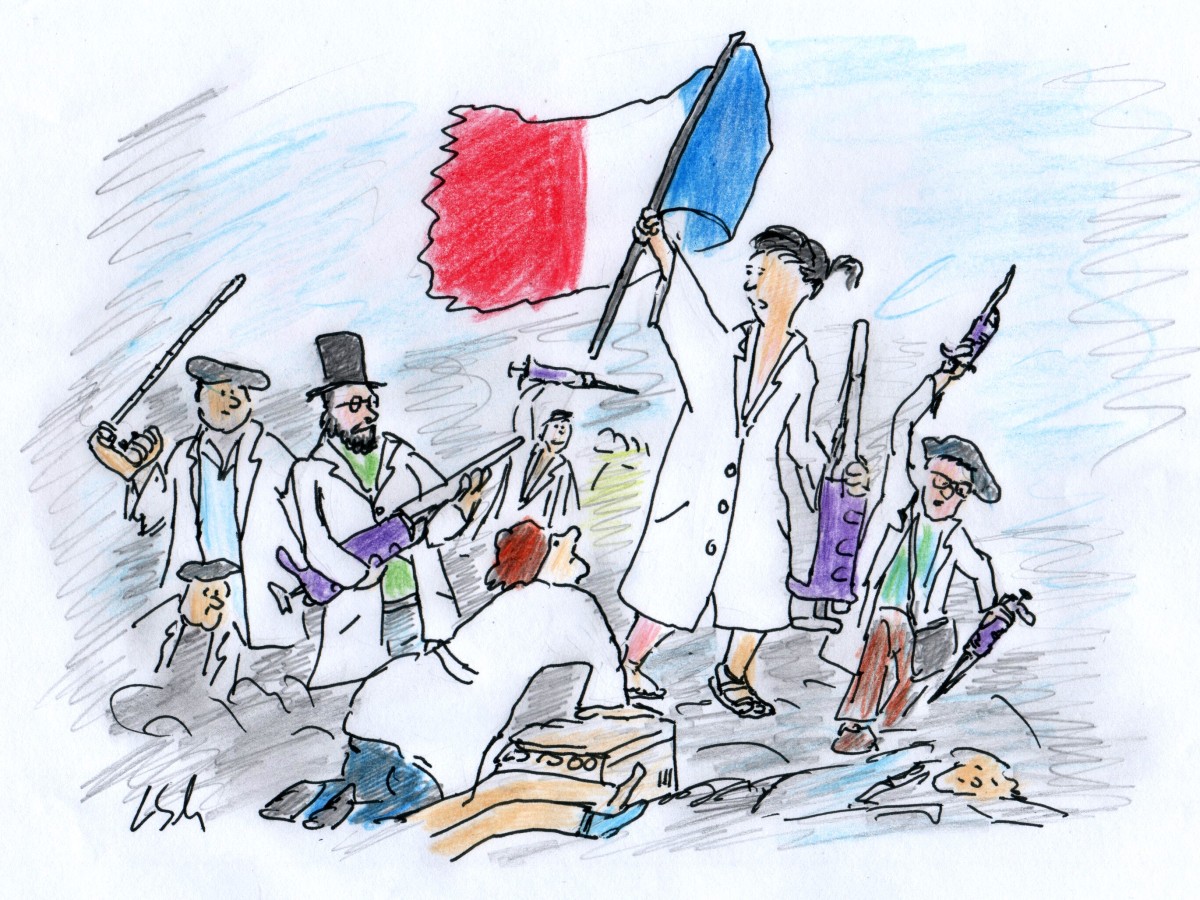



“Martin Bommer , Arndt Benecke , Hinrich Gronemeyer, Cécile Rochette-Egly TIF2 mediates the synergy between RARalpha 1 activation functions AF-1 and AF-2 The Journal of biological chemistry (2002) doi: 10.1074/jbc.m206001200”
Hinrich Gronemeyer also has 3 papers containing problematic data with Lucia Altucci:-
https://pubpeer.com/search?q=gronemeyer+altucci
Lucia Altucci’s own record.
https://pubpeer.com/search?q=lucia+altucci
Often Italain papers slip in one or two people with germanic sounding names.
That is no garantee of authentic data.
LikeLike
Gronemeyer is of course tenured research director in Strasbourg where his talents are valued.
LikeLike
France has just come up with this.
https://www.crisp.ens.psl.eu/
“The main objective of this project is to explore the conditions at which institutional action and discourse on research integrity can improve research practices, to anticipate their impact on ordinary research practices and organization of research, and to propose recommendations.”
It sounds like an academic exercise, not a regulatory body.
LikeLiked by 1 person
Should’ve invited Kroemer.
Click to access 2022_10_13_14Workskop_Leclerc_MichalonIntegrityAffiche-1.pdf
Seriously though, you are right, it’s an academic exercise. Just another public money grave where some academics pad their CVs with performance metrics like grants, papers, conferences on research integrity and the number of PhDs and postdocs they trained.
Click to access JobPost_docMichalonAnnonce-Post-Doc-projet-CRISP3_mai.pdf
LikeLike
France is a halfway house between the corrupted scientific cultures of Italy and Spain,
and most other cultures north of the Alps, with a dash of Stalinism in the
management system thrown in for good measure.
I am sure there are worse countries than Italy and Spain for scientific corruption,
but they are so poor that they cannot even pretend that they are doing science.
China and India spring to mind and evidenced by their cluttering up
the pages of Pubpeer.
LikeLike
Poor? Have you checked the GDP of China and India compared to that of Italy and Spain? and how much of it is invested in R&D? Regardless, I see it in the other way around; the richer a country is, the more it invests in research, and the more fraud it is gonna generate.
LikeLike
GDP of Italy? Problem of confusing cost and worth if it’s science is anything to go on. Can you believe the economic numbers from China, a totalitarian state?
To be blunt about it many of the people I mention problematic science to simply don’t believe anything form India, China, Italy or Spain, perhaps add South Korea to that list. I don’t think that is prejudice, but the evidence of what spews out on the pages of Pubpeer. Japan and the Netherlands are mostly high quality. Fraudsters do appear in Japan, for example Kato, but once the system realises what has happened they are rooted out, part of a culture of quality control. In
LikeLike
A country’s culture affects how science is conducted and therefore the quality of science coming out of it: an interesting (if not rare) example of nurture over nature, IMO. An extreme case of Japanese soul cleansing in scientific research is the poor guy who committed suicide after the STAP fraud. I don’t even think he was directly involved:
https://www.science.org/content/article/senior-riken-scientist-involved-stem-cell-scandal-commits-suicide
I don’t see things like this happening in Italy or Greece. Yes, Greece. ha.
LikeLike
Yoshiki Sasai was extremely involved with Haruko Obokata. Maybe it was the degree of his involvement which drove him to suicide because Japan is not France.
LikeLike
Unfortunately, the situation in the Netherlands and Belgium is far worse than that in France. I cannot help but feel that this has something to do with the ERC (or the EU-REA) failing to hold the culprits accountable for their actions.
LikeLike
I can beleive that Belgium is about the same a France (France written small),
but I do not beleive that the Netherlands is as bad as France.
Rising Pubpeer star in France.
Carmen Garrido.http://www.labex-grex.com/partners/carmen-garrido-inserm-u866/
The works:-
https://pubpeer.com/publications/9A984EC9DEEE1CC4C5EB5D4C64BEA5
https://pubpeer.com/publications/9ABEDB851532E1F2B5C9F93752F296
https://pubpeer.com/publications/6B9B48976D831198B263894F933504
https://pubpeer.com/publications/8587C5AE2BE4965C5EDAC5A95C206C
https://pubpeer.com/publications/DDB33E3D90C48F61F851C0FE6F3ADF
https://pubpeer.com/publications/E588FE51B9ED0070D0D13AE6B2ED26
https://pubpeer.com/publications/E3A0516863DBEE73B4B2C9E391E7FB
https://pubpeer.com/publications/6DC52283A37421FA7F2FAEECCD58D1
https://pubpeer.com/publications/4198C340563EE9FF5D5A7D7CFA12DD
https://pubpeer.com/publications/6CA00633509E674C94C0F2D72182A4
https://pubpeer.com/publications/38EBC8CE314CBEF63E7A34E8732F2A
https://pubpeer.com/publications/4C9F14E87FC3A5B64D7042262A5E9B
LikeLike
Zebedee, I wish that you were right but unfortunately that’s not the case. I’m a part of a Dutch laboratory and I can assure you that almost all the research coming out of the lab is entirely fabricated, or falsified or downright plagiarised.
To be fair though, the research I’m talking about concerns different side of biological sciences than that covered by FBS.
LikeLike
You need to expose the problematic data, i.e. publish the problems, make annotated images (picture is worth 1000 words).
For a start you could publish the problematic data on this site, Pubpeer, or both.
LikeLike
I did expose the research misconduct! And I have been facing retaliation because of that since then. That’s how I learned about the swamp in NL and Belgium, (incl. EU-REA and involvement of some publishers/journal). Turns out institutions would leave no stone unturned when it comes to saving their reputation, except of course punishing the culprits.
As for the problematic data, I’ve only just experimentally demonstrated that their study failed replication (because their results were always fake), so now it’s just a matter of time before I can make it public.
LikeLike
Where can others see this problematic data exposed?
LikeLike
Let me rephrase my last comment: I have only just finished the experiments where I’ve demonstrated the fraudulent data. It’ll take a few months before I can publish it (make it public).
LikeLike
The vast majority of cases of fraudulent science you and your fellow sleuths bring to light were discovered because the ‘researchers’ were lazy and stupid enough to use (parts of) the same images to represent different experiments in their papers. I wonder what would stop a cheating pseudo-scientist from using some random images that are not duplicated in any publication? Every lab has tons of images that are never published. How would you discover that kind of fraud? Lack of reproducibility, perhaps? Do we see only the tip of the iceberg in Pubpeer?
LikeLike
A lot of fraud of the kind you have in mind is being reported by internal whistleblowers: PhD students, postdocs, collaborators. Usually it’s hushed up, whistleblowers get silenced and sacked. Sometimes sued. They write to media who tells them to get lost because one doesn’t write bad things about scientists.
LikeLike
I suppose one reason why whistleblowers don’t get enough traction is that the research in question is often relatively trivial (“the effect of compound X on the expression of Y in organism Z”, even though it is often oversold as “X may help cure cancer/covid/Alzheimer’s”) , so that perhaps only a handful of people in the world really care about the results. Journalists will not be interested. In addition, deliberate fraud can be hard to prove. The fraudster can often claim that some silly mistake was made with the image files and get away with it.
If a result is really important, the experiment will have to be replicated independently before we can assume the results are correct. But who is going to replicate trivial but time-consuming research, which makes up the bulk of published research, fraudulent or
not?
LikeLike
“I did exchange some emails with Loeffler’s PhD student Violaine Sée (now professor at the University of Lyon), who promised to investigate. The situation is serious: ”
Violaine See (previously at Liverpool)https://www.liverpool.ac.uk/systems-molecular-and-integrative-biology/staff/violaine-see/
“I completed my doctorate in molecular and cellular pharmacology in 2001 at the University Louis Pasteur (Strasbourg, France). I moved to the Centre for Cell Imaging at the University of Liverpool in 2002 as a post-doctoral research associate. In 2005 I obtained a prestigious David Phillips Fellowship (BBSRC) to work on intracellular signalling dynamics at the University of Liverpool. ”
2005 David Phillips Fellowship (BBSRC) on the back of these papers:-
2001https://pubpeer.com/publications/FF317B68D900797B92C9F413E534BA
2002https://pubpeer.com/publications/BFEAAAC082A13DE24B98F0F67EA74A
2004https://pubpeer.com/publications/A882B369E5CCE40881DCDE5451133B
I’m sure other people applied for that fellowship.
The BBSRC is a relatively large employer. Its human resuorces department should
identify the highest scoring unsuccessful candidate for 2005 and give the felowship to her/him.
LikeLike
Violaine See did the photo-journalism herself.
Photo from here:
Fellowship from here:
https://www.liverpool.ac.uk/systems-molecular-and-integrative-biology/staff/violaine-see/
Never mind the quality, feel the width!
https://pubpeer.com/search?q=violaine+see
LikeLike
I think that obtaining any fellowship on the back of fraudulent data is fraud. No doubt the BBSRC will turn a blind eye to Violaine See’s fraud. The problem is that the BBSRC is publicly funded, and has through its own lack of due diligence been party to defrauding the tax-payer.
LikeLike
““Martin Bommer , Arndt Benecke , Hinrich Gronemeyer, Cécile Rochette-Egly TIF2 mediates the synergy between RARalpha 1 activation functions AF-1 and AF-2 The Journal of biological chemistry (2002) doi: 10.1074/jbc.m206001200”
Arndt Benecke turns up here: https://pubpeer.com/publications/E12A7D0798ACB2D83B9B1BD350E379
LikeLike
1 French Revolution = 1/2 Protestant Reformation.
LikeLike
thank you for the information
LikeLike
09 May 2023 Strasbourg retraction.
https://academic.oup.com/nar/advance-article/doi/10.1093/nar/gkad358/7152865?login=false
JOURNAL ARTICLE
Retraction of ‘COUP-TF interacting protein 2 represses the initial phase of HIV-1 gene transcription in human microglial cells’
Nucleic Acids Research, gkad358, https://doi.org/10.1093/nar/gkad358
Published: 09 May 2023
This is a retraction to: Nucleic Acids Research, Volume 33, Issue 7, 1 April 2005, Pages 2318–2331, https://doi.org/10.1093/nar/gki529
This is a retraction to: Nucleic Acids Research, Volume 50, Issue 21, 28 November 2022, Page 12600, https://doi.org/10.1093/nar/gkac1167
Issue Section: Retraction
Nucleic Acids Research, Volume 33, Issue 7, 1 April 2005, Pages 2318–2331, https://doi.org/10.1093/nar/gki529
The Editors were alerted in June 2022 about potential issues with Figures 3B, 5C and 6B as detailed below.
Figure 3B: GST bands in the lower two panels appear to be identical.
Figure 5C: There may be signs of splicing around the two COUP-TF bands.
Figure 6B: Lanes 1 and 5 appear to be similar after horizontal flip.
The Editors began their investigation, during which the authors confirmed they no longer have the original, underlying data for any figure contained in the published article, as the research was conducted approximately 20 years ago. The authors also voluntarily disclosed that the upper panels of Figure 5B had ‘been built with at least 14 panels of different gels’.
An Expression of Concern was posted in November 2022. The Editors subsequently referred the matter to the institution where the research was conducted for investigation. The institution enlisted the help of independent external experts to scrutinize the figures objectively. They concluded:
The allegations are plausible and could involve the manipulation of several published images beyond accepted peer-reviewed methodological standards.
In the absence of the original gels, it is not possible to validate some of the conclusions of the article based solely on the experimental data produced in the article.
They are unable to lift all doubts about the conclusions of the article.
Based on their own assessment of the figures and the external experts’ reports, the Editors have lost confidence in the integrity of the data presentation in this paper and are ultimately retracting it.
Original article.
Nucleic Acids Res. 2005; 33(7): 2318–2331. Published online 2005 Apr 22. doi: 10.1093/nar/gki529
PMCID: PMC1084325PMID: 15849318
COUP-TF interacting protein 2 represses the initial phase of HIV-1 gene transcription in human microglial cells
Céline Marban,1 Laetitia Redel,1 Stella Suzanne,1 Carine Van Lint,2 Dominique Lecestre,1 Sylvette Chasserot-Golaz,3 Mark Leid,4 Dominique Aunis,1 Evelyne Schaeffer,1 and Olivier Rohr1,5,*
Author information Article notes Copyright and License information Disclaimer
1INSERM unité 575 Pathophysiology of Nervous System, Centre de Neurochimie, 5 rue Blaise Pascal, 67084 Strasbourg, France
2Institute for Molecular Biology and Medicine, Laboratory of Molecular Virology, 12 rue des Professeurs Jeener et Brachet, 6041 Gosselies, Belgium
3Unité CNRS UPR 2356, 5, rue Blaise Pascal, 67084 Strasbourg, France
4Laboratory of Molecular Pharmacology, College of Pharmacy and Environmental Health Sciences Center, Oregon State University, Corvallis, Oregon 97331-3507, France
5IUT Louis Pasteur de Schiltigheim, 1 Allée d’Athènes, 67300 Schiltigheim, France
*To whom correspondence should be addressed. Tel: +33 388 45 66 01; Fax: +33 388 60 08 06; Email: rohr@neurochem.u-strasbg.fr
LikeLike
Hats off to the Editors of Nucleic Acids Research! In the last 2 years the rate of retraction has increased. Age is no guarantee that a paper will not be retracted.
https://academic.oup.com/nar/search-results?f_TocHeadingTitle=Retraction
LikeLike
HIV is profitable area in which to fake data.
https://peerj.com/CarineVanLint/
https://pubpeer.com/search?q=Carine+van+lint
LikeLike
Eastern France shenanigans.
Georges Herbein.
https://pubpeer.com/publications/35D67F17B6A28A211484F2FD61AF47
Figure 2 is so artistic!
https://www.canceropole-est.org/la-recherche/annuaire-du-canceropole-est/equipes/detail?id=324
https://pubpeer.com/search?q=Herbein
LikeLike
The current editor, Luis Montaner, does nothing about this Journal of Leukocyte Biology paper:
https://pubpeer.com/publications/35D67F17B6A28A211484F2FD61AF47
https://wistar.org/our-scientists/luis-montaner
montanerlab@wistar.org
Perhaps the incoming editor Michael Schnoor, will do something.
https://schnoorlab.com/
mschnoor@cinvestav.mx
LikeLike
The Nucleic Acids Research retraction was the second retraction for Olivier Rohr.
First retraction for Olivier Rohr here:
http://retractiondatabase.org/RetractionSearch.aspx#?auth%3dHerbein%252c%2bG
LikeLike
22 December 2023 retraction for
Detection of Histone Acetylation Levels in the Dorsal Hippocampus Reveals Early Tagging on Specific Residues of H2B and H4 Histones in Response to Learning
Olivier Bousiges ,Romain Neidl ,Monique Majchrzak,Marc-Antoine Muller,Alexandra Barbelivien,Anne Pereira de Vasconcelos,Anne Schneider,Jean-Philippe Loeffler,Jean-Christophe Cassel,Anne-Laurence Boutillier
Published: March 4, 2013
https://doi.org/10.1371/journal.pone.0057816.
https://journals.plos.org/plosone/article?id=10.1371/journal.pone.0296474
After this article [1] was published, concerns were raised about some of the western blots in Figures 1 and 2. Specifically:
In Figure 1B, there are vertical discontinuities between:
Lanes 2 and 3, and 5 and 6 in the K5Ac panel.
Lanes 2 and 3, 4 and 5, and 5 and 6 in the Tetra Ac panel.
Lanes 2 and 3 in the K12Ac panel.
Lanes 2 and 3 in the total H2B panel.
In Figure 2C, there are vertical discontinuities between:
Lanes 1 and 2 in the K12Ac panel.
Lanes 2 and 3 in the Tetra Ac panel.
Lanes 2 and 3, and 6 and 7 in the total H2B panel.
Lanes 2 and 3, and 3 and 4 in the K9K14Ac panel.
Lanes 2 and 3, 3 and 4, and 6 and 7 in the total H3 panel.
During editorial follow up on these issues, the authors stated that the data underlying this article [1] are no longer available.
The corresponding author stated that images were spliced because only a representative subset of samples (lanes) from the original experiments were included in the published figures. The ninth author stated that the data presented in Figures 1B and 2C in [1] were provided as illustrations, and that the semi-quantitative data reported in [1] correspond to evaluations referencing each assessment to the control from the same experimental sample. The captions for Figures 1B and 2C in [1] state that ‘Typical western blots are presented/shown in duplicates’.
The corresponding author also stated that total histones were not run on the same gel as modified histones as they migrate to the same position on the gel, but they indicated all quantifications were performed using the appropriate corresponding control samples.
In the absence of the original raw image data, the above concerns cannot be resolved and PLOS cannot verify the reliability of the reported results and conclusions. Therefore, the PLOS ONE Editors retract this article.
ALB, MM, AB, APdV, OB, JCC, RN, and MAM did not agree with the retraction. AS and JPL either did not respond directly or could not be reached.
ALB stands by the article’s findings.
Reference
1.Bousiges O, Neidl R, Majchrzak M, Muller M-A, Barbelivien A, Pereira de Vasconcelos A, et al. (2013) Detection of Histone Acetylation Levels in the Dorsal Hippocampus Reveals Early Tagging on Specific Residues of H2B and H4 Histones in Response to Learning. PLoS ONE 8(3): e57816. pmid:23469244
https://pubpeer.com/publications/EE8DAEE8F0E75ADBE18E2A252E89C9
LikeLike
Must be a French thing, to declare figures mere illustrations.
LikeLike
Problematic data.
https://pubpeer.com/search?q=Laurent+D%C3%A9saubry
LikeLike
https://www.nature.com/articles/d41586-024-00589-5
NEWS 26 February 2024
” ‘Incomprehensible’: scientists in France decry €900-million cut to research”
‘Incomprehensible’ is third decade 21st century moral indignation from a professional class, which has not kept its house in order.
Perhaps quite comprehensible.
LikeLike